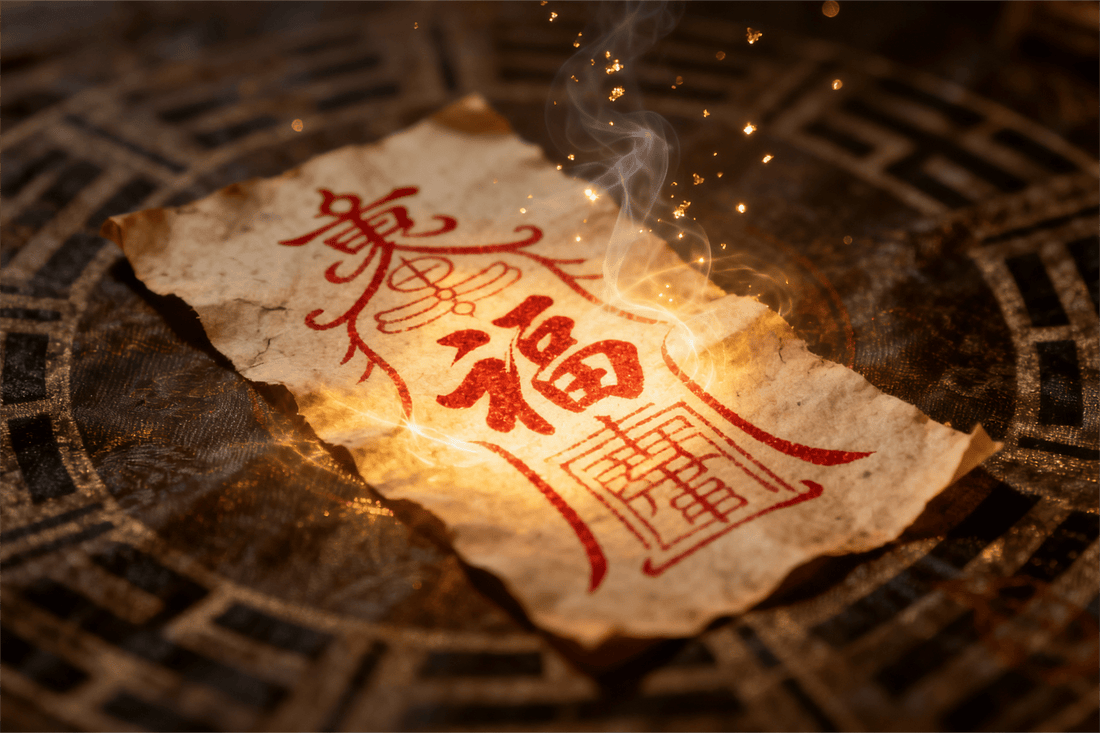
The Most Powerful Taoist Symbols in Feng Shui
Share
In the intricate tapestry of Feng Shui practice, Fu sigils (符咒) stand as powerful conduits of intention—ancient protection charms that bridge the celestial and terrestrial realms. These ritual objects, often misunderstood as mere superstition, form a sophisticated symbolic language for energy cleansing and spatial harmony. Rooted in Taoist cosmology and integrated into geomancy, they reveal how cultural symbols shape both physical and energetic environments.
1、The Essence of Fu Sigils: Sacred Geometry in Ink
Fu sigils are not random drawings but precise energy maps combining:
Celestial Script (天文): Star constellations and planetary symbols
Seal Characters (篆文): Deformed Chinese characters encoding prayers
Esoteric Geometry: Spirals, dots, and lines representing Qi flow patterns
Example: The Five Thunder Sigil (五雷符) invokes thunder deities for purification. Its zigzag lines mimic lightning’s disruptive force to shatter stagnant energy.
2、Protection Charms: Three Layers of Energetic Defense
Talismans in Feng Shui operate through:
| Layer | Function | Common Forms |
|---|---|---|
| Preventive | Block Sha Qi before entry | Doorway talismans, mirror Ba Gua |
| Cleansing | Dissolve existing negativity | Fu sigils burned to ash, sprinkled in water |
| Invocatory | Attract benevolent forces | Star deity symbols in wealth areas |
Case Study: Hong Kong’s Bank of China Tower controversially used angled designs to "deflect" neighboring Sha Qi—a modern architectural interpretation of Fu principles.
3、Ritual Objects: From Consecration to Activation
Talismans require ceremonial empowerment:
Ink Alchemy: Red ink (yang energy) mixed with cinnabar, rainwater, and herbal essences
Timing: Drawn during Yang hours (11 PM–1 AM) or solar terms like Spring Equinox
Invocation: Taoist priests chant Zhouyu (咒语) to imbue intent, as recorded in Daozang scriptures
Modern Twist: 3D-printed talismans with conductive inks are tested in MIT’s Tangible Media Lab for electromagnetic shielding.
4、Energy Cleansing: The Five-Element Detox Protocol
Fu sigils cleanse spaces through elemental resonance:
Metal (Bell sounds): Shatters stagnant energy with vibrations
Water (Salt sprinkling): Absorbs and purifies negativity
Wood (Smudging): Pine or sandalwood smoke lifts heavy Qi
Fire (Candle focus): Projects intention through flame
Earth (Crystal grids): Grounds purified energy into stability
Data Point: NIH studies show smudging reduces airborne bacteria by 94%, validating ancient purification practices.
5、Cultural Symbols: Bridging Archetypes and Architecture
Beyond functionality, talismans embody cultural narratives:
Eight Trigrams (八卦): Represent cosmic cycles, often engraved on thresholds
Taijitu (太极): Balances Yin-Yang in room dividers or garden layouts
Luo Shu Grid (洛书): Guides furniture placement using number magic
Urban Application: Singapore’s Parkroyal Hotel integrates living walls with embedded Ba Gua motifs, merging ecology with energy design.
6、Ethical Practice: Talismans in Contemporary Geomancy
Modern challenges require ethical reflection:
Cultural Appropriation vs. Appreciation: Western use of Fu sigils as decor risks stripping sacred context
Scientific Integration: Architects like Steven Holl test "symbolic resonance" in healing centers
Accessibility: Open-source Fu designs emerge for DIY energy cleansing, debated by traditionalists
Conclusion: Symbols as Living Energy
Feng Shui talismans are not relics but living tools—where brushstrokes become boundaries, and intentions shape reality. As Taoist master Ge Hong proclaimed: "The sigil is a vessel; its power flows from the heart-mind union." In decoding these cultural symbols, we discover a universal truth: That protection begins not in space, but in consciousness.
